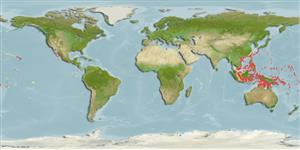>
Gobiiformes (Gobies) >
Gobiidae (Gobies) > Gobiinae
Etymology: Ctenogobiops: Greek, kteis, ktenos = comb + Latin, gobius = gudgeon + Greek, ops = appearance (Ref. 45335).
Eponymy: Not a true eponym but referring to Tangaroa, a powerful Maori/Polynesian deity, god of the sea. (Ref. 128868), visit book page.
Environment: milieu / Zona climática / intervalo de profundidade / distribution range
Ecologia
marinhas associadas(os) a recifes; intervalo de profundidade 4 - 40 m (Ref. 1602), usually 4 - 40 m (Ref. 27115). Tropical; 22°C - 25°C (Ref. 27115); 30°N - 15°S
Pacific Ocean.
Tamanho / Peso / Idade
Maturidade: Lm ? range ? - ? cm
Max length : 6.0 cm TL macho/indeterminado; (Ref. 9710)
Descrição suscinta
Chaves de identificação | Morfologia | Morfometria
Espinhos dorsais (total) : 7; Raios dorsais (total) : 10 - 11; Espinhos anais: 1; Raios anais : 10 - 11. Characterized by having semi-translucent whitish body; orange spots interspersed with small white or bluish spots on body; dorsal fin brownish "pennant"; basal part of pectoral fin with white marking forming long, diffuse narrow white streak; greatly prolonged first and second dorsal spines; longitudinal scale series 47-51; opening of gill extending forward to vertical at posterior edge of eye; greatest depth of body 4.3-5.2 in SL; rounded caudal fin, except straight in central part, about equal to head length (Ref. 90102).
Body shape (shape guide): elongated; Cross section: circular.
Occurs in patches of fine sand on seaward reefs and uses alpheid shrimp burrows for refuge. Found in clear coastal and inner reefs on rubble flats and slopes in 6-20 meters depth range (Ref. 48637).
Ciclo de vida ou comportamento de acasalamento
Maturidade | Reprodução | Desova | Ovos | Fecundidade | Larvas
Randall, J.E., G.R. Allen and R.C. Steene, 1990. Fishes of the Great Barrier Reef and Coral Sea. University of Hawaii Press, Honolulu, Hawaii. 506 p. (Ref. 2334)
Status na Lista Vermelha da UICN (Ref. 130435: Version 2025-1)
Ameaça para os humanos
Harmless
Uso pelos humanos
Pescarias: espécies comerciais; Aquário: Espécies comerciais
Ferramentas
Relatórios especiais
Baixar XML
Fontes da internet
Estimates based on models
Preferred temperature (Ref.
123201): 24.8 - 29, mean 27.9 °C (based on 530 cells).
Índice de diversidade filogenética (Ref.
82804): PD
50 = 0.5020 [Uniqueness, from 0.5 = low to 2.0 = high].
Bayesian length-weight: a=0.00724 (0.00339 - 0.01546), b=3.10 (2.92 - 3.28), in cm total length, based on LWR estimates for this (Sub)family-body shape (Ref.
93245).
Nível Trófico (Ref.
69278): 3.3 ±0.4 se; based on size and trophs of closest relatives
Resiliência (Ref.
120179): Elevada, tempo mínimo de duplicação da população menor que 15 meses (Preliminary K or Fecundity.).
Fishing Vulnerability (Ref.
59153): Low vulnerability (10 of 100).
🛈
Nutrients (Ref.
124155): Calcium = 201 [87, 423] mg/100g; Iron = 0.974 [0.466, 1.924] mg/100g; Protein = 17.8 [15.8, 19.5] %; Omega3 = 0.103 [0.043, 0.212] g/100g; Selenium = 28.4 [12.1, 68.9] μg/100g; VitaminA = 126 [32, 469] μg/100g; Zinc = 2.55 [1.60, 3.89] mg/100g (wet weight);
